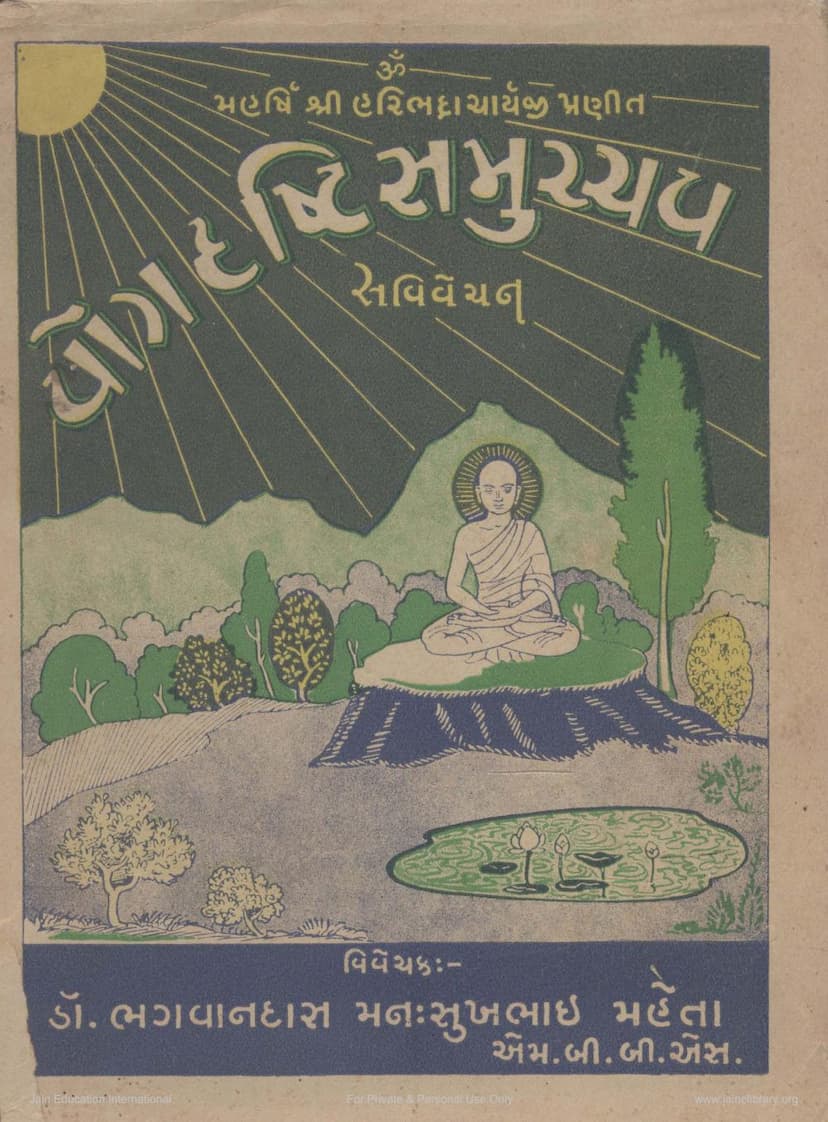Yogdrushti Samucchaya
Added to library: September 2, 2025

Summary
This is a comprehensive summary of the Jain text "Yogdrushti Samucchaya" by Acharya Haribhadrasuri, with commentary by Dr. Bhagwandas Manasukhbhai Mehta, based on the provided pages.
Title: Yogdrushti Samucchaya (Collection of Perspectives on Yoga) Author: Acharya Haribhadrasuri Commentator/Scholar: Dr. Bhagwandas Manasukhbhai Mehta Publisher: Mansukhlal Mehta, Mumbai Publication Year: 1950 (V.S. 2006)
Overall Summary:
"Yogdrushti Samucchaya" is a foundational Jain text attributed to the revered Acharya Haribhadrasuri, a prominent scholar and monk of the Jain tradition. This particular edition features a detailed commentary and explanation by Dr. Bhagwandas Manasukhbhai Mehta, an MBBS doctor, highlighting his deep engagement with spiritual and philosophical texts alongside his medical expertise. The book delves into the profound subject of Yoga from a Jain perspective, aiming to guide spiritual seekers towards ultimate liberation (Moksha).
Key Themes and Content:
The commentary by Dr. Mehta provides a meticulous analysis of Acharya Haribhadrasuri's work, exploring the stages of spiritual development, the nature of Yoga, and the path to self-realization within the Jain framework.
-
The Nature of Yoga: The text defines Yoga as a supreme path, superior to even Wish-fulfilling gems (Chintamani) and considered the most important of all dharmas (righteous duties). It is the means to attain self-At-tainment and liberation. The book emphasizes that Yoga is not merely physical but encompasses a holistic approach to spiritual development.
-
The Eightfold Yoga (Ashtanga Yoga) and Jain Yoga: The text draws parallels between the eight limbs of Patanjali's Yoga (Yama, Niyama, Asana, Pranayama, Pratyahara, Dharana, Dhyana, Samadhi) and the Jain concept of eight Yoga perspectives or stages. Acharya Haribhadrasuri masterfully integrates these concepts, explaining how the initial stages of Yoga (Mitra, Tara, Bala, Dipti) correspond to the initial ethical disciplines, while the later stages (Sthira, Kanta, Prabha, Para) represent deeper meditative states that lead to the dissolution of ignorance and the attainment of higher consciousness.
-
The Eightfold Yoga Perspectives (Ashta Yoga Drishti): The core of the text lies in its detailed explanation of the eight progressive stages or perspectives of Yoga as elucidated by Acharya Haribhadrasuri. These stages are:
- Mitra (Friend): Characterized by initial stages of spiritual aspiration, perhaps with a slight degree of underlying ignorance.
- Tara (Star): A slightly more advanced stage.
- Bala (Strength): Indicating growing spiritual strength.
- Dipti (Radiance): Signifying a dawning of inner light or understanding.
- Sthira (Steadfast): A stage of firm resolve and unwavering practice, where ignorance begins to significantly diminish.
- Kanta (Lovely/Desirable): A stage of profound spiritual insight and attraction.
- Prabha (Luminosity): A stage of enhanced inner radiance and understanding.
- Para (Supreme): The final stage of Yoga, signifying complete realization and liberation.
-
Integration of Spiritual and Ethical Development: The commentary highlights how these Yoga perspectives are not merely philosophical concepts but are deeply intertwined with ethical conduct, inner purification, and the cultivation of virtues like non-violence (Ahimsa), truthfulness (Satya), non-stealing (Asteya), celibacy (Brahmacharya), and non-possession (Aparigraha) – the Yamas – and purity, contentment, austerity, self-study, and surrender to the Divine – the Niyamas.
-
The Role of a Guru and Scripture: The text emphasizes the indispensable role of a Sadguru (true spiritual guide) and scripture (Agama) in the journey of Yoga. A true Guru illuminates the path and helps overcome obstacles, while scripture provides the framework and guidance.
-
Overcoming Obstacles (Vighna): The commentary discusses various obstacles on the spiritual path, such as ego, attachment, desires, and the limitations of sensory perception, and offers practical means to overcome them through self-awareness, ethical discipline, and deep contemplation.
-
The Ultimate Goal – Moksha: The text consistently points towards Moksha (liberation) as the ultimate aim, achieved through the purification of the soul, the eradication of karmic bonds, and the realization of the true, inherent nature of the soul as pure consciousness, bliss, and infinite knowledge.
-
Commentary by Dr. Mehta: Dr. Bhagwandas Mehta's commentary is highly detailed and scholarly. He meticulously breaks down each verse of Acharya Haribhadrasuri's work, providing Sanskrit explanations, poetic translations, and extensive explanations in simple Gujarati. He also draws upon various philosophical and religious texts, including Jain Agamas, other Indian scriptures, and the teachings of great philosophers, to enrich the understanding of Yoga. His commentary emphasizes the practical application of these principles for spiritual upliftment.
Significance of the Text:
"Yogdrushti Samucchaya," with Dr. Mehta's insightful commentary, serves as a comprehensive guide for both beginners and advanced practitioners of Yoga seeking spiritual enlightenment. It offers a unique Jain perspective on Yoga, integrating ancient wisdom with a clear, accessible explanation, making it a valuable resource for anyone interested in the profound journey of self-discovery and liberation. The commentary itself is a testament to the translator's deep understanding and dedication to spiritual scholarship.